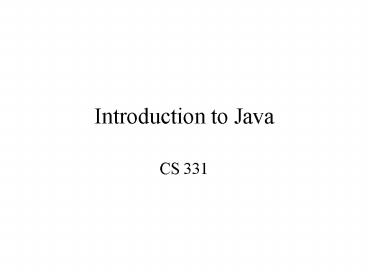Introduction to Java - PowerPoint PPT Presentation
Title:
Introduction to Java
Description:
Introduction to Java CS 331 Introduction Present the syntax of Java Introduce the Java API Demonstrate how to build stand-alone Java programs Java applets, which run ... – PowerPoint PPT presentation
Number of Views:208
Avg rating:3.0/5.0
Title: Introduction to Java
1
Introduction to Java
- CS 331
2
Introduction
- Present the syntax of Java
- Introduce the Java API
- Demonstrate how to build
- stand-alone Java programs
- Java applets, which run within browsers e.g.
Netscape - Example programs
3
Why Java?
- Its the current hot language
- Its almost entirely object-oriented
- It has a vast library of predefined objects and
operations - Its more platform independent
- this makes it great for Web programming
- Its more secure
- It isnt C
4
Applets, Servlets and Applications
- An applet is designed to be embedded in a Web
page, and run by a browser - Applets run in a sandbox with numerous
restrictions for example, they cant read files
and then use the network - A servlet is designed to be run by a web server
- An application is a conventional program
5
Building Standalone JAVA Programs (on UNIX)
- Prepare the file foo.java using an editor
- Invoke the compiler javac foo.java
- This creates foo.class
- Run the java interpreter java foo
6
Java Virtual Machine
- The .class files generated by the compiler are
not executable binaries - so Java combines compilation and interpretation
- Instead, they contain byte-codes to be executed
by the Java Virtual Machine - other languages have done this, e.g. UCSD Pascal
- This approach provides platform independence, and
greater security
7
HelloWorld (standalone)
public class HelloWorld public static void
main(String args) System.out.println("Hell
o World!")
- Note that String is built in
- println is a member function for the System.out
class
8
Comments are almost like C
- / This kind of comment can span multiple lines
/ - // This kind is to the end of the line
- / This kind of comment is a special
javadoc style comment /
9
Primitive data types are like C
- Main data types are int, double, boolean, char
- Also have byte, short, long, float
- boolean has values true and false
- Declarations look like C, for example,
- double x, y
- int count 0
10
Expressions are like C
- Assignment statements mostly look like those in
C you can use , , etc. - Arithmetic uses the familiar - /
- Java also has and --
- Java has boolean operators !
- Java has comparisons lt lt ! gt gt
- Java does not have pointers or pointer arithmetic
11
Control statements are like C
- if (x lt y) smaller x
- if (x lt y) smallerxsum xelse smaller
y sum y - while (x lt y) y y - x
- do y y - x while (x lt y)
- for (int i 0 i lt max i) sum
i - BUT conditions must be boolean !
12
Control statements II
switch (n 1) case 0 m n - 1 break
case 1 m n 1 case 3 m m n break
default m -n break
- Java also introduces the try statement, about
which more later
13
Java isn't C!
- In C, almost everything is in functions
- In Java, almost everything is in classes
- There is often only one class per file
- There must be only one public class per file
- The file name must be the same as the name of
that public class, but with a .java extension
14
Java program layout
- A typical Java file looks like
import java.awt.import java.util. public
class SomethingOrOther // object definitions
go here . . .
This must be in a file named SomethingOrOther.java
!
15
What is a class?
- Early languages had only arrays
- all elements had to be of the same type
- Then languages introduced structures (called
records, or structs) - allowed different data types to be grouped
- Then Abstract Data Types (ADTs) became popular
- grouped operations along with the data
16
So, what is a class?
- A class consists of
- a collection of fields, or variables, very much
like the named fields of a struct - all the operations (called methods) that can be
performed on those fields - can be instantiated
- A class describes objects and operations defined
on those objects
17
Name conventions
- Java is case-sensitive maxval, maxVal, and
MaxVal are three different names - Class names begin with a capital letter
- All other names begin with a lowercase letter
- Subsequent words are capitalized theBigOne
- Underscores are not used in names
- These are very strong conventions!
18
The class hierarchy
- Classes are arranged in a hierarchy
- The root, or topmost, class is Object
- Every class but Object has at least one
superclass - A class may have subclasses
- Each class inherits all the fields and methods of
its (possibly numerous) superclasses
19
An example of a class
class Person String name int age
void birthday ( ) age
System.out.println (name ' is now ' age)
20
Another example of a class
class Driver extends Person long
driversLicenseNumber Date expirationDate
21
Creating and using an object
- Person johnjohn new Person ( )john.name
"John Smith"john.age 37 - Person mary new Person ( )mary.name "Mary
Brown"mary.age 33mary.birthday ( )
22
An array is an object
- Person mary new Person ( )
- int myArray new int5
- or
- int myArray 1, 4, 9, 16, 25
- String languages "Prolog", "Java"































